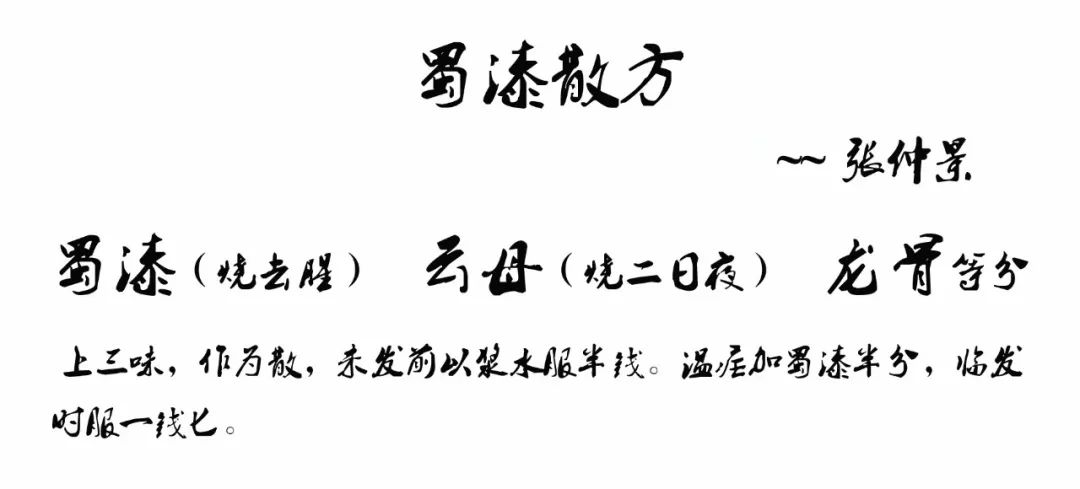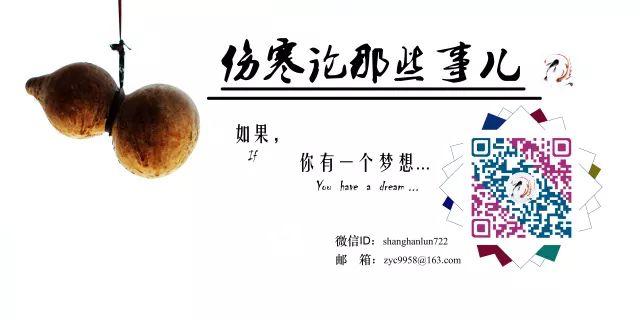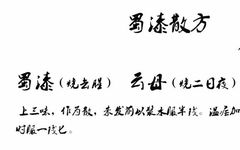
Diagnosis and Treatment of Malaria Pulse Patterns, Section 4

Section 5
If malaria is characterized by more cold, it is called “Mu Malaria” (牡疟), treated with the formula “Shu Qi San” (蜀漆散).


Introduction: The editor of the “Essentials of the Golden Chamber” has categorized the content according to the methods outlined in Liu Duzhou’s commentary on the text. Annotations are primarily drawn from works of Qing Dynasty and modern medical practitioners, and may reflect personal biases. Readers are encouraged to extract the essence and discard the dross, integrating the knowledge with clinical practice and personal understanding. Comments and contributions from readers regarding expert discussions or personal annotations are welcome!


Commentary by Zi Heng
Malaria often presents with alternating chills and fever. If there is more cold than heat, it is termed “Mu Malaria”. This may be due to deficiency of Yang Qi or the inability of Yang Qi to resist external pathogens. The formula “Shu Qi San” is indicated, as it addresses the cold phlegm obstructing Yang Qi, leading to a predominance of cold over heat in malaria. The formula includes Shu Qi to expel phlegm and treat malaria, Yun Mu to resolve phlegm and transform dampness, and Long Gu to consolidate Yang Qi.


Qing Dynasty – You Yi, “Essentials of the Golden Chamber” Heart Classic
If malaria is characterized by more cold, it is not true cold. Yang Qi is obstructed by phlegm and fluids, unable to reach the surface, and remains hidden in the heart. The heart is the “Mu” organ, hence the name “Mu Malaria”. Shu Qi can expel malaria phlegm; once phlegm is eliminated, Yang can extend and cold will improve. Yun Mu and Long Gu are used to prevent the aggressive nature of Shu Qi from disturbing the spirit and Qi within the heart.


Qing Dynasty – Wu Qian, “Medical Canon of the Golden Mirror”
[Comment]
This refers to “Mu Malaria”; the text is concise, as detailed in the “Inner Canon” and requires no further explanation.


Qing Dynasty – Huang Yu, “Golden Chamber Suspended Explanation”
Discussion on malaria: If malaria begins with cold and then heat, it is due to summer heat causing the pores to open, and encountering cold water, which becomes trapped in the skin. If autumn wind causes illness, the disease manifests. Cold is Yin Qi, while wind is Yang Qi; thus, the initial injury is from cold followed by wind, leading to cold first and then heat. The disease occurs seasonally, termed cold malaria.
Cold first, heat later, is due to Yang being constrained by Yin, thus it is hidden and cold. Yang Qi is unable to rise, resulting in more cold than heat. If Yang fails to rise, it results in pure cold without heat. Malaria characterized by more cold indicates excess Yin and deficiency of Yang, where cold pathogens stagnate and hide in the Shao Yang region. It must be expelled; Shu Qi San, Yun Mu eliminates dampness and cold, and Long Gu consolidates turbid stagnation, allowing Shu Qi to expel the accumulation and restore Yang Qi.


Qing Dynasty – Cao Yingfu, “Golden Chamber Elucidation”
The reason malaria is characterized by more cold is that the skin is obstructed by water Qi, preventing Yang Qi from dispersing. Water Qi accumulates in the upper diaphragm, leading to phlegm and fluids, hence the saying “no phlegm, no malaria”. Shu Qi, a common mountain herb, can eliminate damp phlegm, thus it is used as the main ingredient. Yun Mu stone, as stated in the “Classic of Herbs”, treats wind-cold and heat, and is effective for dizziness caused by travel. Long Gu is likely a misinterpretation of oyster; the “Classic of Herbs” states that oyster treats cough and phlegm, indicating that Shu Qi San is specifically designed for wind-phlegm dizziness. Once the damp phlegm in the upper diaphragm is eliminated, Yang Qi can be expressed, supporting the saying that “no phlegm, no malaria” is credible.


Qing Dynasty – Shen Mingzong, “Zhang Zhongjing’s Essentials of the Golden Chamber”
This is a formula for more cold than heat. In malaria characterized by more cold, it is like a division of three to seven or two to eight; malaria onset must be due to the Wei pathogen entering the Ying level, resulting in cold, while the Ying pathogen exiting the Wei level results in heat. This indicates that the Wei pathogen is more prevalent than the Ying pathogen, preventing the Ying pathogen from dispersing, leading to external cold; accumulated fluids form phlegm, hence the prevalence of cold, which differs from the “Suwen” (素问) discussion of Shao Yin syndrome characterized by more heat than cold. The formula uses Shu Qi with water to expel the pathogen, allowing Yang Qi to rise: Long Gu consolidates and restrains Yin fluids; Yun Mu raises Yang from below, embodying the essence of mountain and river clouds clearing. Yun Mu is the root of Yang Qi stone, warm and ascending, best at eliminating dampness and moving phlegm; when combined with Shu Qi, it can treat Tai Yin damp malaria. The formula concludes with a note: for damp malaria, add half a dose of Shu Qi, while the original text mistakenly refers to it as warm malaria, which is a significant error. Zhang’s annotations provide a reference for consideration.

Inheriting and Promoting Traditional Chinese Medicine is Our Responsibility!
Copyright Notice
Copyright Notice: Some content of this article is excerpted from “Liu Duzhou’s Commentary on the Essentials of the Golden Chamber”; author/Liu Duzhou; “Hu Xishu’s Lectures on the Essentials of the Golden Chamber”; lecturer/Hu Xishu. The purpose of reprinting is to disseminate knowledge of Traditional Chinese Medicine culture, and the copyright belongs to the relevant rights holders. If there are any improper uses, please feel free to contact us for negotiation. The section titled “Commentary by Zi Heng” is original content; please indicate the source when reprinting.

Full Chapter Content
Section 1: The Master said: The pulse of malaria is string-like; a rapid string pulse indicates more heat, a slow string pulse indicates more cold, a tight string pulse indicates a deficiency, while a slow pulse can be warmed; a tight pulse can be treated with sweating or acupuncture. A floating large pulse can be expelled; a rapid string pulse indicates wind invasion, which can be stopped by dietary adjustments.
Section 2: In cases of malaria, if it occurs on the first day of the month, it should resolve by the fifteenth; if it does not resolve, it should be treated by the end of the month; if it still does not resolve, what should be done? The Master said: This is a mass forming a lump, termed “Malaria Mother”, requiring urgent treatment with turtle shell decoction.
Section 3: The Master said: If Yin Qi is isolated and Yang Qi is alone, it results in heat with little Qi, causing restlessness, with hot hands and feet and a desire to vomit, termed “Dan Malaria”. If there is only heat without cold, it indicates that the pathogenic Qi is hidden in the heart, causing the flesh to decay.
Section 4: Warm malaria has a pulse like a flat line, with no cold but heat, joint pain and restlessness, occasional vomiting, treated with Bai Hu Jia Gui Zhi Tang.
Section 5: If malaria is characterized by more cold, it is called “Mu Malaria”, treated with “Shu Qi San”.
Appendix: Formula from “Secret Essentials of the External Platform”
Oyster Decoction. Treats Mu Malaria.
Chai Hu with Ban Xia and Gua Lou Decoction. Treats thirst in malaria, also treats labor malaria.
Chai Hu Gui Jiang Decoction. Treats malaria with more cold and slight heat, or only cold without heat.

Thoroughly Read and Recite

Section 5: If malaria is characterized by more cold, it is called Mu Malaria, treated with Shu Qi San.





